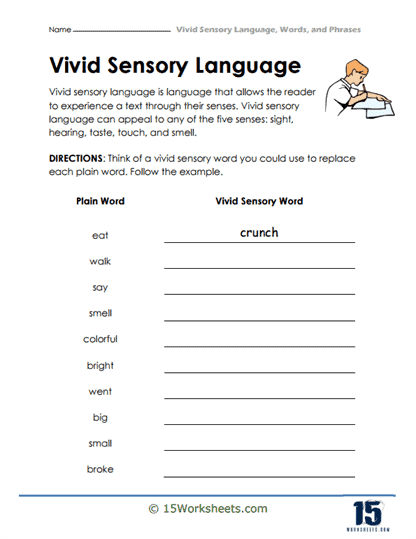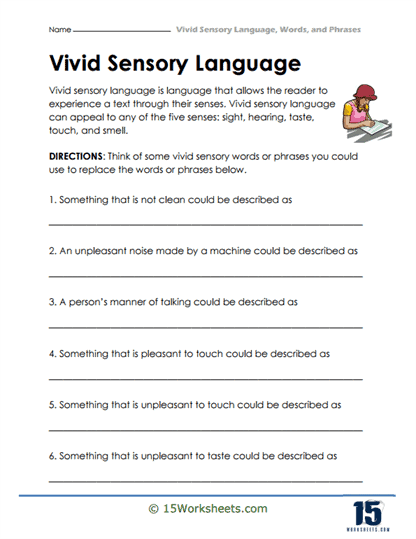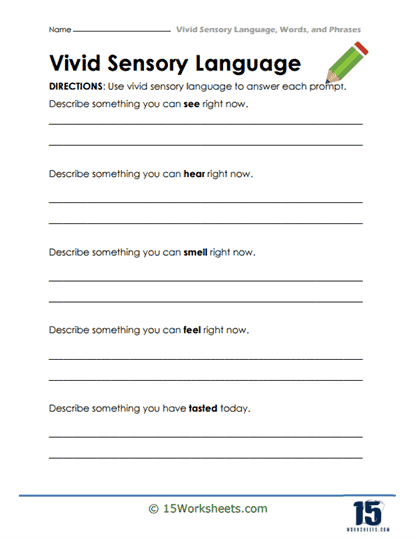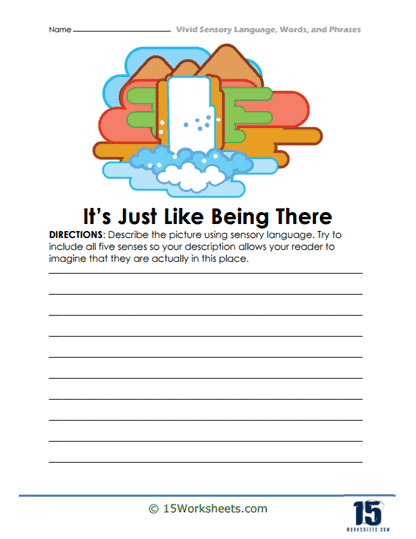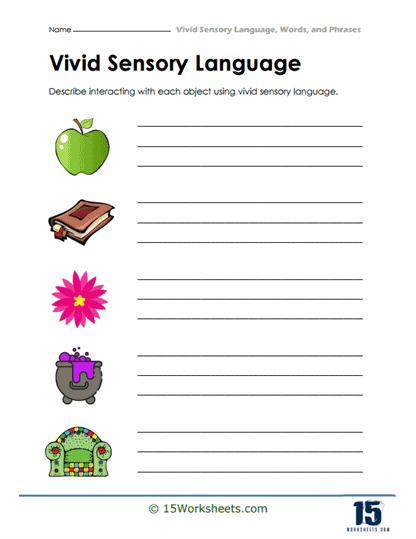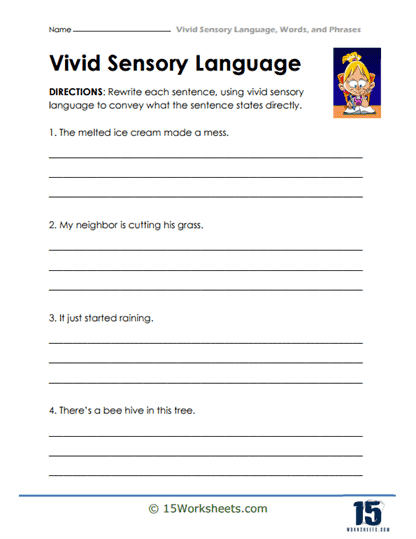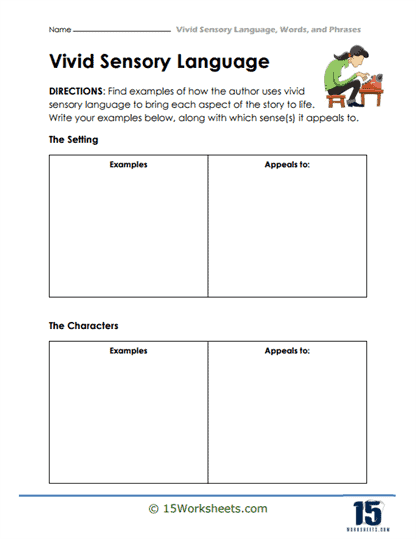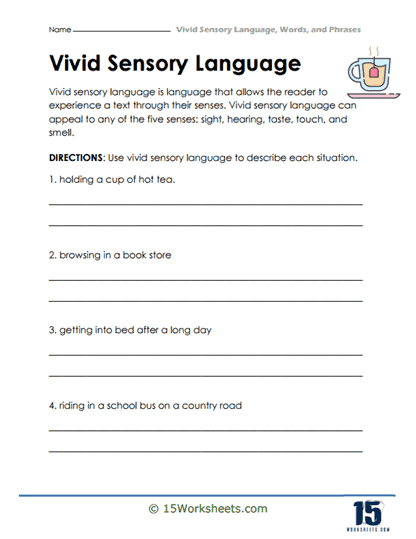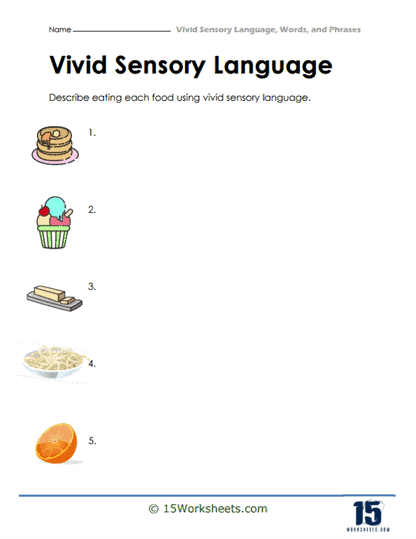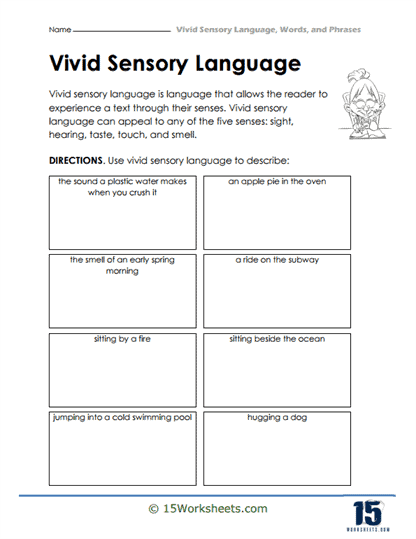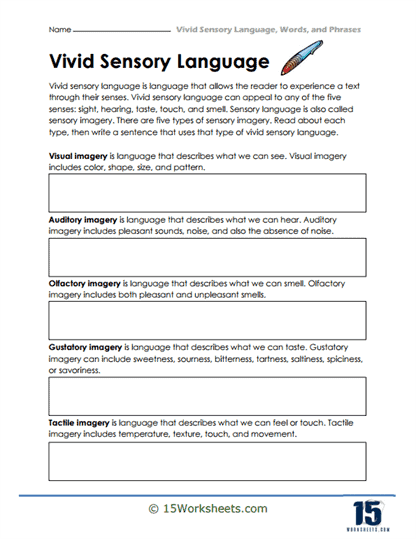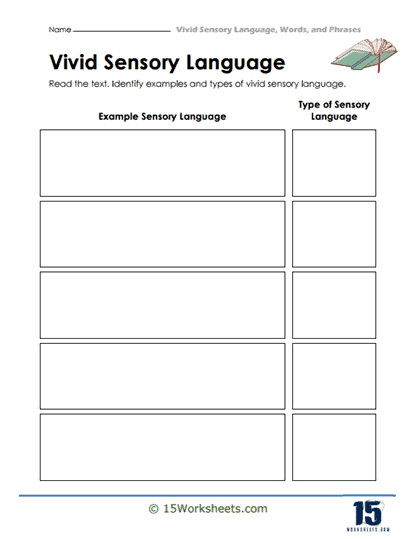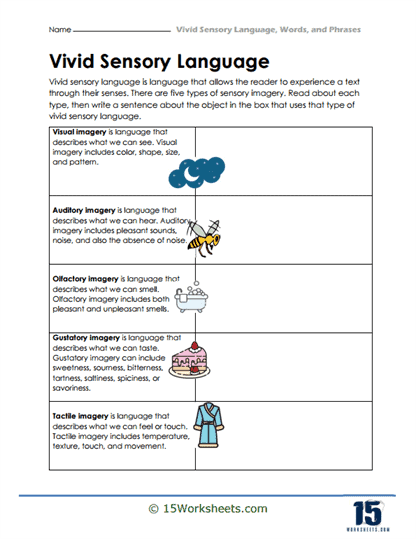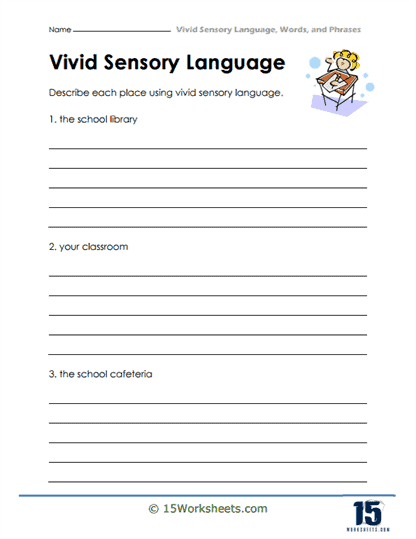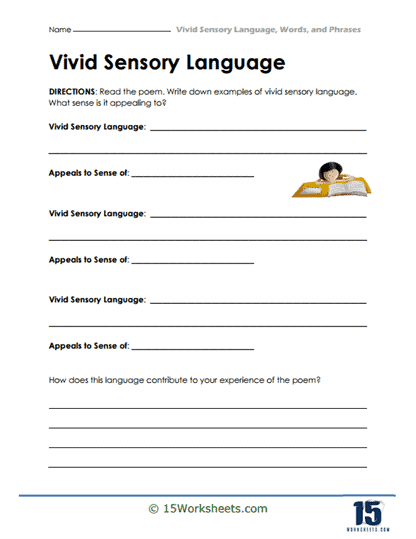Vivid Sensory Language Worksheets
All About These 15 Worksheets
Unlocking the full potential of descriptive writing can be transformative for any student, turning a simple piece of text into an immersive experience that draws readers in. This series of 15 worksheets is meticulously crafted to help students tap into one of the most effective tools in the writer’s arsenal: sensory language. By focusing on engaging the five senses, these worksheets guide students on a journey of discovery, enabling them to create vibrant, engaging narratives that leap off the page and into the reader’s imagination.
The magic of sensory writing lies in its ability to evoke an emotional and physical response from readers. Think about a time when you were reading a story and could almost taste the bitterness of coffee, hear the distant rustle of leaves, or feel the damp chill of a rainy day. These moments of vivid description are what make writing memorable. Sensory details create an immersive experience, and through this collection of worksheets, students will learn how to masterfully incorporate these elements into their writing.
At the heart of this series is the goal of helping students understand the transformative impact that sensory language can have on their writing. Too often, young writers focus solely on the events of their story-what happens, when it happens, and why. While this is important, it can leave the reader detached from the experience. Through these worksheets, students will begin to see writing not just as a means of conveying facts, but as a tool for creating worlds, sparking emotions, and transporting readers to new places. They will learn that the true power of descriptive writing lies not in telling the reader what’s happening, but in showing it through a vivid tapestry of sensory experiences.
Each worksheet introduces students to the five senses-sight, sound, smell, taste, and touch-by focusing on one sense at a time. This allows students to deeply explore how each sense can be used to enhance their writing. For instance, students may begin by exploring how visual imagery can be used to create striking mental pictures. They will learn how to use color, light, and shadow to paint scenes that feel real and tangible. From the golden glow of sunlight filtering through trees to the ominous darkness of a stormy night, students will learn to describe not just what they see, but how it feels to see it.
Next, they’ll dive into the world of sound, discovering how to use auditory descriptions to create atmosphere and mood. Whether it’s the soft crackle of a campfire, the distant murmur of voices in a bustling market, or the eerie silence of an abandoned house, students will come to understand how sound can set the tone of their writing and pull readers into the moment. They’ll experiment with onomatopoeia, alliteration, and rhythm to make their writing as auditory as it is visual.
But sight and sound are only part of the equation. Smell, taste, and touch-the often-overlooked senses-are equally crucial for creating truly immersive descriptions. Students will learn how to describe the scent of freshly baked bread or the musty odor of an old attic in ways that evoke powerful memories and emotions in their readers. They’ll practice describing tastes, whether it’s the sweetness of ripe fruit or the sharp tang of vinegar, to enrich their storytelling. And through tactile descriptions, they’ll explore how the physical sensations of touch-from the roughness of sandpaper to the smoothness of silk-can make a scene come alive in the reader’s mind.
As students progress through the series, they will also be challenged to creatively describe pictures, using vivid sensory language to bring static images to life. This exercise not only sharpens their descriptive abilities but also trains them to observe the world more keenly, developing an attentive eye for detail. They will learn that writing is not just about putting words on paper, but about capturing the essence of an experience in a way that resonates deeply with the reader.
In addition to honing their sensory language, students will also learn specific techniques for refining their descriptive writing. They will explore how to avoid clichés and overused phrases, instead crafting fresh, original descriptions that surprise and delight their readers. They’ll learn to balance sensory details with narrative flow, ensuring that their descriptions enhance rather than overwhelm the story. And, perhaps most importantly, they will develop an awareness of how sensory details can evoke emotion and create a stronger connection between the reader and the story.
By the end of the series, students will have a comprehensive toolkit for mastering descriptive writing. Whether they’re working on a personal narrative, a poem, a descriptive essay, or a creative short story, they will be equipped to infuse their writing with sensory richness that captivates readers. No longer will their compositions be flat, one-dimensional recounts of events; instead, they will be vivid, multi-sensory experiences that transport readers to the heart of the story.
The impact of mastering sensory language extends beyond the classroom. As students become more proficient in the art of description, they also become more observant and thoughtful in their everyday lives. They begin to notice the details of the world around them-the way sunlight filters through leaves, the sound of footsteps on gravel, the scent of rain on the pavement. This heightened awareness enriches their writing and fosters a deeper connection to the world, encouraging them to be more mindful, creative individuals.
What is Vivid Sensory Language?
Vivid sensory language refers to the use of descriptive words, phrases, and imagery that engage the reader’s senses and evoke a vivid sensory experience. It involves incorporating sensory details related to sight, hearing, taste, touch, and smell into written compositions to create a more immersive and vivid reading experience.
When employing vivid sensory language, writers strive to paint a picture in the reader’s mind by appealing to their senses. This can be achieved through the careful selection of words and the use of descriptive techniques such as similes, metaphors, and personification. By incorporating sensory details, writers enable readers to mentally experience the scene or event being described, making the writing more engaging, memorable, and relatable.
- For example, instead of simply stating, “The flower was beautiful,” a writer employing vivid sensory language might describe the flower as, “The delicate petals of the vibrant red rose unfurled, releasing a captivating scent that permeated the air, while its velvety texture invited a gentle touch.”
By incorporating sensory details like the color, scent, and texture, the writer transports the reader into the scene, allowing them to visualize and experience the beauty of the flower firsthand.
Vivid sensory language adds depth, richness, and authenticity to writing, allowing readers to connect with the text on a sensory level. It enables writers to create more vivid and memorable descriptions, evoke emotions, and engage readers’ imaginations, ultimately enhancing the overall impact and effectiveness of their written compositions.
Different Types of Sensory Language
- Visual Imagery: This type of sensory language appeals to the sense of sight. It involves using descriptive words and phrases to create mental images in the reader’s mind. It includes vivid descriptions of colors, shapes, sizes, patterns, and visual details of people, objects, or settings.
Example: “The sun dipped below the horizon, casting a warm golden glow across the tranquil lake, turning its surface into a shimmering mirror.”
- Auditory Imagery: Auditory imagery focuses on the sense of hearing, using words and phrases to describe sounds. It can evoke different tones, pitches, volumes, rhythms, and qualities of sounds, whether they are loud or soft, melodic or jarring.
Example: “The waves crashed against the rugged shoreline, their powerful roar filling the air with a symphony of nature’s might.”
- Olfactory Imagery: Olfactory imagery pertains to the sense of smell. It involves describing scents and aromas in a way that allows readers to imagine and experience them in their minds. It can evoke memories and emotions associated with specific smells.
Example: “The kitchen was filled with the irresistible aroma of freshly brewed coffee, wafting through the air and awakening the senses.”
- Gustatory Imagery: Gustatory imagery relates to the sense of taste. It uses descriptive language to evoke the sensation of different tastes, flavors, and textures of food and drink. It allows readers to savor and imagine the flavors being described.
Example: “The velvety chocolate melted on the tongue, releasing a burst of bittersweet ecstasy that lingered long after the last bite.”
- Tactile or Kinesthetic Imagery: Tactile or kinesthetic imagery appeals to the sense of touch and physical sensations. It describes the texture, temperature, and physical qualities of objects, surfaces, or actions. It can evoke sensations of smoothness, roughness, softness, or hardness.
Example: “The sand, warm and grainy, slipped between her toes as she walked along the sun-kissed beach, leaving a tingling sensation of pure bliss.”
By incorporating these different types of sensory language, writers can create a multi-dimensional experience for readers, allowing them to engage their senses and immerse themselves in the writing. The key is to select sensory details that are relevant, evocative, and enhance the overall narrative or message of the piece.

